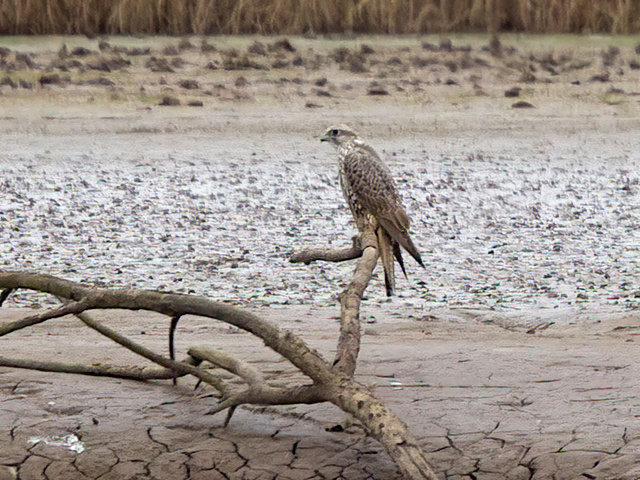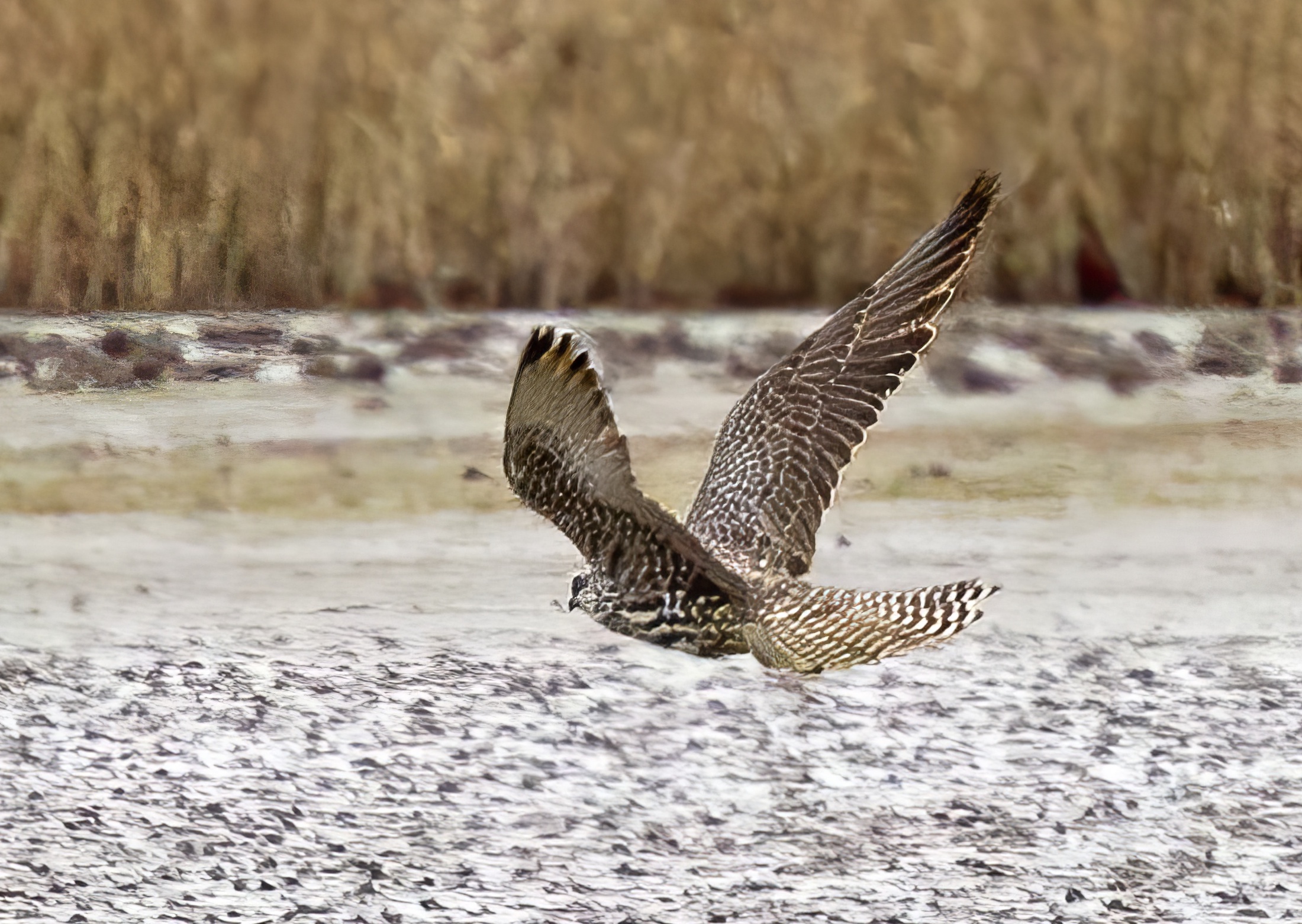Gyr Falcon Falco rusticolus


| Site | First date | Last date | Count | Notes |
| Twigmoor | 1826, exact date unknown | 1 | White morph, trapped, skin said to be in the Strickland collection, obtained Isle of Axholme | |
| Saxilby | December 1900 | 1 | Immature female grey morph, shot. | |
| Humber estuary, Far Ings NR | 16/02/2013 | 1 | Grey morph. | |
| Humber estuary, Read's Island | 09/03/2013 | 10/03/2013 | 1 | Same grey morph bird as 16th February. |
Gyr Falcon Falco rusticolus: Barton Pits and Read 's Island, February-March 2014
by Graham Catley.
Circumstances
On the evening of 9th March 2014, I was passing Read's Island and stopped to count the Avocets. It was immediately obvious that all the birds on the island were in the air; two of the resident Marsh Harriers were high up with a flock of Lesser Black-backs, but they all seemed wary and were flying in an odd manner. Looking down I saw a large falcon sat upright on the front edge of the island, and it looked immediately interesting with grey-brown uppers and paler underparts heavily marked with dark streaks and chevrons; the striking legs and feet were blue-grey and the paler head had a darker malar and eye stripe with a blue-grey cere; I watched it through the 'scope for two minutes, then went for the camera at which point it flew off, of course, and chased a flock of Shelduck before landing at 700m on the back of the island. I phoned Neil Drinkall (ND), who was with me in 15 minutes, and four other observers arrived before dark, but views were by then poor at 700m and after sunset in rapidly fading light.
I returned the following morning at 09:00 and found the bird in the same location; ND arrived soon after and we watched it for two hours at 600-700m range . It was sometimes flying but always away from us out over the estuary where it may have landed on a sand bar out of sight. At 11.00 it flew towards us, and I took some photos with a 500mm lens and 2x converter, hand-held in poor light, bur at least they showed most of the features of the bird. It then landed on a washed up tree at 400m range after being chased by two Carrion Crows and more images were obtained of the spread tail, legs, and tibia! feathers and spread upper wing. After about 10 minutes, it then flew to the western end of the island where it perched on another tree before we left at 11:30 after which we were informed it flew south ten minutes later.
Description
Obviously, a large falcon with a deep chest and a longer tail than Peregrine's, wing tips falling short of tail tip at rest (photos above).
- Bill heavy and strong with blue-grey cere; legs and feet again strong and blue-grey with darker claws.
- Upper parts mainly grey-brown with paler feather tips and three large creamy spots at tips of largest upper scapulars; crown and nape paler creamy coloured with smudgy grey markings; dark line through eye and dark malar stripe.
- Underparts creamy base colour with heavy brown streaking on upper breast becoming darker and heavier on lower breast and flanks where they turned into chevrons; tibial feathers also heavily marked with dark brown streaks and spots, cloaking the legs most of the time.
- Upper tail barred across all feathers with paler creamy bars narrower than the dark grey-brown bars, same pattern on upper tail coverts.
- Upper wings quite uniform but with slightly darker primaries and barred inner webs to primaries on spread wing. Under wings striking with heavy barring on greater coverts and finer barring on lesser and median coverts contrasting with much paler underside of flight feathers that were also faintly barred.
A heavy bird in flight but very manoeuvrable and capable of sudden bursts of speed; deep chested and front heavy but with broad undertail coverts. The blue-grey cere and legs/feet and the pattern of the upperpart feathers identify the bird as a juvenile/first-winter.
Identification and a twist
After the sighting on the 9th, I was not at all sure about the bird's specific identity, being aware that various falconer's hybrids can closely resemble Gyr Falcons and having in fact seen a very pale bird resembling a Gyr near Scunthorpe several years previously. So, I posted some shots online and asked for people's comments while I checked all the available literature and also looked through a wide range of images on the internet. By the time I received comments from some renowned Gyr experts, I was concluding that the bird was most likely a grey Gyr in spite of the seemingly almost mythical recent status of this form in Britain. In fact, there had been an accepted record of a juvenile near Stone Creek on the north bank of the estuary in November 2013 and this was most probably the same individual. These were some of the replies to enquiries on Bird Forum:
Edward Inselaf from Iceland: “Sadly, I have no experience of Saker and happily I have no experience of falconry hybrids, but I've seen lots of Gyr Falcons, and this bird looks fine to me, perhaps warmer brown than your average bird but they do vary. Plenty of young Icelandic Gyr images to peruse here - www.flickr.com/photos/eyjovil...h/10496574303/”
Nils van Duivendijk (forwarded by the late Martin Garner): “About that falcon: to me it looks very good for Gyr, but I don't need to mention that a theoretical hybrid with Saker is often very difficult to exclude. Meanwhile I do not see anything that is 'strange' for Gyr. If a hybrid, I would expect more underwing contrast, not such a very typical juv Gyr flank-feather pattern, more contrast between darker secondaries and pale primaries (underside) - none in this one (like Gyr) - typical broad wings with rounded wingtip. Maybe one thing (as far I can see) is generally more in line with Saker and that's the very vague barring on the base of the underside of the primaries which is often more pronounced in Gyr. But this is a paler bird than the juv Continental Gyrs usually seen in Europe, so I guess that this is not a very strange feature for a paler juv grey-type Gyr”.
I submitted the bird to the BBRC along with all my photos and it was duly accepted but a strange twist ensued as it emerged that Mandy West had photographed what she took to be an odd Peregrine as it flew past Far Ings, Barton, on 16th February 2014. Her image clearly showed it to be the same Gyr Falcon. Presumably it had been somewhere around the upper Humber during the intervening period.
The status of non-white Gyr Falcons in Britain may have been clouded by the lack of acceptance of such birds in recent years but in fact a majority of the old records in Britain were of this form and it is only in recent years that white birds have dominated the statistics as described in the Gyr Falcon entry in the latest BOU checklist (Parkin , D. T. & Knox, A .G. 2010. The Status of Birds in Britain & Ireland. Helm, London). There have been about 150 records in the UK since 1950 and at least 200 prior to that date: about two thirds from Scotland. Grey birds are commonest in October-January, whereas white predominate in February-April. In the 25 years from 1950 to 1975, less than 40% of birds were white phase, since then the figure has risen to over 65%. Presumably, the white birds come from Greenland (certainly more white birds are recorded from Ireland than elsewhere in the UK), but why there should be an increase in these is unclear. Perhaps the situation is the reverse and the impression of an increase in white birds is due to fewer non-white ones coming to UK and Ireland as warming of the Arctic reduces the need to leave the breeding grounds in N Russia and Scandinavia.
Reference
(Account as per new Birds of Lincolnshire (2021), included October 2022)

